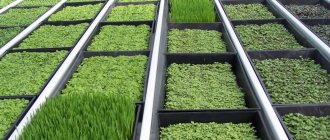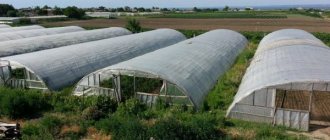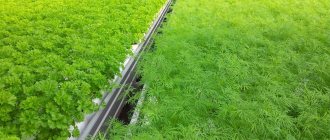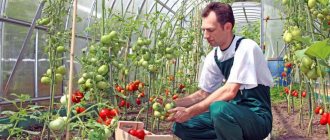Fresh greens are a source of vitamins and microelements. It is included in a large number of dishes. Therefore, citizens and organizations actively purchase the product. According to RBC, the market capacity in Russia is about $100 million. Since 2015, the indicator has shown stable growth. There are not enough domestic products. The volume of imported goods on the Russian market is 106.7 thousand tons. At the same time, consumers are ready to purchase Russian products. A decline in demand is not predicted in the near future. Therefore, you can make good money by organizing the production of greens in greenhouses.
1. Analysis of the market and competitors 2. Risk assessment 3. Legal registration of business 4. Step-by-step plan for the production of greens 5. Selection of equipment and greenhouse 6. What greens to grow 7. Purchase of seedlings and seeds 8. Recruitment of employees 9. Technology of growing greens 10. Planting and growing greens in the ground 11. Planting and growing greens using hydroponics 12. Marketing plan 13. Calculating expenses and income 14. Conclusion
Project Description
The goal of the project is to obtain a stable income from growing and selling greens. This line of business is actively developing. The demand for fresh greens increases every year, which is associated with an increase in the number of our fellow citizens choosing a healthy diet, as well as with a decrease in import volumes.
If you organize sales of grown products, you will not only quickly recoup your initial investment, but also receive a decent, stable income.
Goals and objectives
The goal is business development, increasing production and sales volumes.
Achieving this goal is directly related to solving a number of problems:
- selection of land for establishing production;
- studying the niche and choosing the crops most in demand among buyers;
- creating optimal conditions for growing;
- search and development of optimal ways to sell grown products.
Greens are a perishable commodity. Your main task is to implement it immediately after harvesting.
Choosing a growing method
Greens are grown for sale in three ways:
- At home (on the balcony, window sills, loggias). Disadvantages: small production volume, average quality of greens. Advantages: you will be able to sell your goods in the winter, during the period of maximum demand, you will test the market and your crop-growing abilities.
- At the dacha, personal plot. Disadvantages: seasonality, dependence on climate. Advantages: high quality greens, growing a wide range of crops, “testing” the market.
- In a greenhouse or greenhouse. Disadvantages: you need start-up capital to set up greenhouses, a little knowledge of agronomy, land, personnel, established sales channels. Advantages: this is a full-fledged entrepreneurial activity that promises good profits if the business is properly organized.
If you are aiming to earn a good income, choose the greenhouse growing method.
Heating of winter greenhouses and methods of regulating and maintaining thermal conditions
The main task of the greenhouse is to maintain optimal temperature conditions and humidity. These are necessary parameters for the proper growth and development of plants. This also includes requirements for ensuring the necessary humidity and illumination, and carbon dioxide content.
Favorable temperatures for plant development are created by the heating system. Correct calculations and installation of heating is impossible without taking into account external factors.
Conventionally, they are divided into: consumables and incoming Consumables : heat losses of fences, losses during ventilation and air infiltration. Incoming : the amount of heating heat, the heat of sunlight.
The most significant incoming thermal factor is heating. It can be implemented using the energy of superheated water, heating elements, or be air.
Air heating of a greenhouse
Water heating is based on the circulation of liquid with an inlet temperature of up to 95 degrees and an outlet temperature of up to 70 C°. In soil heating systems, the water temperature is about 40 °C.
Air heating of the air when growing lettuce in a greenhouse in winter is implemented in numerous ways. Primary energy can result from the combustion of gas, electric current, heat from steam or superheated water.
Scheme of a greenhouse with water pipe heating
The water pipe heating system has become more widespread in greenhouses. Pipes are placed vertically one above the other, 5-6 pieces along the fence above the soil surface and at the height of the tent. The adrenal heating sections are connected to common pipes using flexible hoses. Electric pumps are used to circulate hot water.
The advantages of such heating are the ease of creation and uniform heating of the entire volume of air.
Soil heating of a greenhouse
For soil heating, plastic pipes with a diameter of 20-40 mm are often used. To do this, they are buried parallel to each other at a depth of 40 cm. The distance between the pipes is determined individually and can range from 30 to 100 cm. The standard temperature of the coolant in the system is 40 C°.
To improve heating efficiency, it is important to minimize heat loss. This can be achieved by using modern materials with high thermal insulation qualities and installing screens. Regardless of the technical design, the principle of reducing heat loss lies in installing two layers of material. An air gap is formed between the layers, which has high thermal insulation properties. Double insulation of film greenhouses reduces heat loss by up to 30% while simultaneously reducing light penetration by up to 10%. It is important to promptly repair ventilation vents and seal cracks through which heat is lost.
Heating devices and communications must be in good working order and operate in the required temperature ranges. Often, hydroponic lettuce does not produce the worst harvest results for sale.
Market and competitor analysis
Analyze the market situation and competitors’ offers yourself or involve professionals from consulting companies (if you have the funds for this).
Market analysis implies:
- determining the number of competitors in the regional market;
- studying their range and price offers;
- determination of demand in different periods of the year;
- identifying risks and pitfalls.
Competitor analysis:
- determining the number of competitors and the “style” of their work (seasonal, permanent);
- analysis of pricing principles;
- study of the assortment.
According to the consulting company, as of December 2022, the harvest of greenhouse vegetables and salad crops was 3 times higher than the yield of the agro-industrial complex. In 2022, greenhouse areas in Russia increased by 200 hectares. The growth of the industry is associated with restrictions on imports and increased investment.
Marketing plan
The main task of the marketing plan is to organize sales of products immediately after they are collected, so pay close attention to finding buyers.
All means are good to attract customers:
- Commercial offers for shops, supermarkets, restaurants, cafes, snack bars.
- Search for resellers with optimal price offers.
- Creating your own website, searching for buyers through social networks.
- Retail sales at the local market.
Use all ways to attract customers. This is the only way your products will become in demand and your business profitable.
Profitability, sales
Sales of greens can be done in several ways:
- to restaurants, cafes, canteens and other catering establishments;
- through our own retail outlets;
- through resellers;
- to the shops.
At the same time, in order to sell in retail stores, you need to obtain various sanitary documents. But in the event of a sale on the market, you can get away with demonstrating documents about the presence of a household plot.
Collection of greens
Advice! Greens must be sorted by size before selling. Then she looks pretty.
But selling greens in large volumes is always quite difficult due to high competition. Try to win the trust of the buyer not only by dumping prices, but also by the quality of the products - let your greens be beautifully packaged, fresh and green. This is exactly the case when it is better not to be greedy, but to sell only fresh products.
Transparent and durable packaging for greens
Greens are vacuum packed
Trapezoidal bag for packaging greens
On a note! The profitability of “green” businesses is quite high. Sometimes it even reaches 500%. But don’t be mistaken about some of the numbers - from 1 m2 you will not collect the declared 4-5 kg of greens (they write about this on many sites). The actual volume of products from such a territory is about 2-3 kg.
The profitability of a “green” business can reach 500%
Step-by-step production plan
The production plan combines the selection of territory, equipment for greenhouses, selection and purchase of planting material, personnel search, as well as solving other organizational issues.
Let's take a closer look at each of the points.
Step 1. Selecting equipment and greenhouses
To open a business you will need 3-5 greenhouses made of glass, polycarbonate or acrylic. The cheapest option is plastic film, but it is short-lived and breaks from wind and weather conditions.
In addition to the frame you need:
- soil cultivation equipment;
- soil feeding;
- equipment for heating and lighting of the greenhouse;
- rack structures;
- equipment for installing an irrigation system;
- thermometers, humidity sensors.
The purchase and installation of equipment is an important stage on which productivity and the convenience of staff work depend.
Step 2. Installation of the greenhouse
Installation begins with the foundation and installation of supporting parts of the structure. The presence of a foundation is not necessary, but with it your crop will be reliably protected from rodents and pests. In cold regions, the foundation will prevent heat loss.
Metal welded structures are used as a base (frame), onto which polycarbonate sheets are attached.
Choose a site for greenhouse farming close to communications. Otherwise, you will incur additional costs for every meter of water supply and sewerage connected to it.
The next stage is the installation of an irrigation system, a hydroponics system (growing greens without soil), heating and lighting. When they are installed, the soil is prepared. It needs to be loosened, fertilized, and moistened.
The business plan should contain information about the material and model of the greenhouse, as well as information about who will install it.
Step 3. Purchasing seeds
Greens are grown from seeds, bulbs and seedlings. Buy planting material only from trusted sellers. Over time, you will collect seeds yourself, but for the first time, visit specialized stores or greenhouse complexes.
Step 4. Recruitment
For 5 greenhouses you will need 15-18 employees.
Personnel costs depend on the number of personnel and production volumes. If the volumes are modest, many novice entrepreneurs save on hiring a sales manager and accountant.
The list of employees and their approximate salary is given in the table:
| Job title | Responsibilities | Approximate salary, rub |
| Manager or engineer | Monitoring the work of employees, the operation of heating and lighting systems, purchasing seeds | 40 000-45 000 |
| Handyman | Watering, loosening the soil, harvesting, packing greens | 18 000 -25 000 |
| Driver | Delivery of products to the point of sale | 20 000 — 25 000 |
| Sales manager | Finding clients, resolving product sales issues | 30 000 -35 000 |
| Accountant | Accounting, accrual of salaries to employees | 25 000 -30 000 |
| Security guard | Ensuring the safety of greenhouses | 15 000 -20 000 |
Entrust your accounting to an outsourcing specialist. By concluding a cooperation agreement with him, you will not have to hire a full-time employee.
What greens are best to grow?
Which is better: parsley, onions, cilantro, sorrel, radishes or pea beds? Should you choose one crop or grow several? You need to solve these questions at the stage of drawing up a business plan.
Let's look at the features of the most popular crops.
Green onions
It is unpretentious and grows quickly. Some varieties bear fruit all year round. There are spicy and sweet types of onions. Sweet ones take longer to grow, but are in great demand. This plant is not difficult to grow even on a windowsill in an apartment or on a balcony, so when choosing an onion, be prepared to face serious competition.
Forcing onions to grow requires a large planting area, since the distance between the bulbs planted for greens must be at least 10 centimeters.
Parsley and dill
These crops are sown by seeds. Parsley is biennial, that is, it bears fruit for two years and produces seeds, which are collected and re-sowed in the garden. Dill produces a bountiful harvest. Gardeners get up to 6 kilograms of greenery from one square meter.
The sowing density of these crops (distance between seeds) is 5 centimeters. Parsley and dill are heat-loving and love sunny weather. On cloudy days they will need additional lighting.
Salad
This is the most profitable and fastest growing crop. 25 days after sowing, you are guaranteed a real “green fire” in the beds. There are several types of lettuce: watercress, arugula, lettuce, frisse, curly or curly lettuce.
They need regular watering and do not tolerate heat well. The most popular type of lettuce is leaf lettuce. It is cut when the leaves are still small. After pruning, bushes need feeding.
Sorrel, celery, basil
Celery loves well-fertilized, loose soil. Tolerates cold weather. Loves abundant watering. Its main disadvantage is that the seeds take a long time to ripen; cut leaves quickly deteriorate. Daylight hours affect the growth of celery. If you want to get a harvest quickly, do not skimp on lighting the greenhouse.
Sorrel grows in one place for 2-3 years. The first leaves appear 12-14 days after sowing the seeds. It is grown in open ground, in a greenhouse. It is in greatest demand from buyers from February to May. In summer, demand drops.
This is how sorrel grows
Basil is picky about temperature. Loves warmth, does not tolerate heat well. It is advisable to regularly ventilate the greenhouse with it. The leaves of the plant are for sale, which must be carefully cut off so as not to tear out the stem by the roots. Basil is not demanding in care and bears fruit well.
Spinach
It is planted in early spring. It bears fruit within a month after sowing. The leaves sell well in the spring. In summer there is a decline in consumer interest. A new wave of buyer activity is late autumn. The plant produces a harvest for a long time.
By planting a second batch of seeds in late May or early June, you will be supplying your customers with fresh, vitamin-rich greens until December.
Organizational plan
An organizational plan is the official registration of a business with state control authorities and the hiring of personnel. Without official registration, you will not establish sales.
Selling greens without documents is allowed if you grow them in your apartment and rely on clients from among your friends or neighbors, or in small retail trade on a spontaneous market.
Business registration
To make money from growing and selling greens in a greenhouse, it is enough to register an individual entrepreneur. An alternative is to organize an LLC with two founders. The optimal taxation system is the Unified Agricultural Tax (USAT). According to it, tax payments will be only 6% of the income.
Opening schedule
Opening schedule is a calendar plan in which each item of activities for opening a business is entered, indicating the timing of its implementation. With its help, you specify your actions by tying them to clear deadlines. For example, you plan to spend 1 month searching for a suitable plot of land, renting it, and installing greenhouses on it.
The table provides a clear example of a business opening schedule.
| Action | February | March | April |
| Search and lease of land | + | ||
| Purchase of equipment, installation of greenhouses | + | + | |
| Installation of heating, lighting, ventilation | + | + | |
| Paperwork | + | ||
| Search and recruitment of personnel | + | + | |
| Purchase of seeds, fertilizers | + | ||
| Beginning of work. Sowing seeds, planting bulbs, seedlings | + | + |
How to prepare soil for salad?
If an entrepreneur is not going to invest money in a hydroponic installation, he will have to start preparing special soil that will supply the plants with nutrients. Since lettuce can be harvested at least 6–8 times in a greenhouse per year, ordinary soil will not cope with this task. What do we have to do:
- Neutral formulations with pH 6.0–7.0 are suitable for growing Iceberg lettuce in the country or in a greenhouse. If necessary, acidity is reduced by liming;
- Greenhouse soil is prepared by mixing 5 parts of garden soil, 3 parts of rotted manure and 1 part of coarse sand. You can also buy ready-made peat substrate;
- In the greenhouse, in place of the beds, depressions of 20–25 cm are made, and then the soil is filled in so that the total thickness of the nutrient mixture is 40–45 cm;
- Two weeks before planting, 10–15 g of potassium and 20–30 g of phosphorus are added per square meter of soil as part of complex fertilizers. Then the beds are well watered.
Financial plan
Financial planning is the most important part of a business plan. Your expenses directly depend on the size of your business.
Let's consider the approximate annual financial forecast of income and expenses of an individual entrepreneur growing greens in 5 greenhouses.
| № | Indicators | Amount in rubles per year |
| 1 | Sales revenue | 11 600 000 |
| 2 | Rent of land | 250 000 |
| 3 | Staff salaries | 4 450 000 |
| 4 | Fertilizers, chemical treatments | 230 000 |
| 5 | Heating | 790 000 |
| 6 | Electric heating costs | 234 000 |
| 7 | Watering | 45 000 |
| 8 | Packaging materials | 270 000 |
| 9 | Depreciation of agricultural equipment | 110 000 |
| 10 | Planting material | 85 000 |
| 11 | other expenses | 300 000 |
| 12 | Income before taxes | 4 200 000 |
| 13 | Tax (6% according to Unified Agricultural Tax) | 252 000 |
| 14 | Net income | 3 948 000 |
Want to save money when starting out? Build a greenhouse with your own hands. Use a simple watering hose instead of an automatic one and use solid fuel heating instead of electric. This way you will keep start-up costs to a minimum, evaluate your strengths in agronomy and test the market.
Approximate plan for monthly greenhouse expenses:
| № | Cost item | Size (RUB) |
| 1 | Payment of rent | 45-50 000 |
| 2 | Communal payments | 10-12 000 |
| 3 | Staff salaries | 180-200 000 |
| 4 | Paying tax | 20 000 |
| 5 | Costs for fertilizer, containers, equipment | 10 000 |
| Total: | 292 000 |
Greenhouse equipment
Industrial greenhouses most often use hydroponic technologies . They can significantly save space and reduce the cost of finished products. Plants are grown in liquid nutrient solutions, without the use of soil.
Hydroponic technologies significantly accelerate the growth of greenery , and the plants have a beautiful appearance. Unlike vegetables, greens grown hydroponically do not develop a watery taste.
Another option is soil cultivation in tiers . Along the walls of the greenhouses there are racks with a nutrient substrate into which the seeds are sown. Rack growing makes it possible to save on heating costs by increasing the number of plants per square meter. m greenhouse.
The greenhouse is equipped with a ventilation and heating system. Industrial greenhouses are heated using pipes laid underground. To reduce electric heating costs, innovative methods are actively used: biofuels, solar panels, and the use of infrared cables. It is best to heat the structure in a combined way, using several methods at once.
Industrial greenhouses designed for soil cultivation must be equipped with a drip irrigation system . Lighting is also very important. Lamps under the ceiling are not enough; local lighting is needed for each tier of the rack.
To organize a continuous process, batch sowing is recommended. This allows you to harvest without overstocking. After harvesting, the soil is mixed with fertilizers , thoroughly loosened, watered and sown with a new batch of seeds.
Possible risks and guarantees
There are few risks in a greenhouse operation that operates all year round, but they should not be underestimated.
Have you decided to start growing green onions, basil, dill or parsley?
You risk encountering:
- high competition;
- high prices for heating greenhouse premises;
- seasonal fluctuations in consumer demand;
- failure of heating, watering or lighting equipment;
- low yields due to the wrong choice of crop growing methods.
The profitability of this area of business is guaranteed by the reduction in imports of salad crops from other countries, as well as the interest of investors in the greenhouse business, which has been experiencing a real boom since 2014.
How to sell salad?
If you grow lettuce on a windowsill from seeds in winter, the resulting harvest will be enough, at best, to satisfy your personal needs. But in industrial greenhouses the weight of products reaches several tons, which forces the entrepreneur to look for ways to quickly sell them. At first glance, it is most profitable to agree on cooperation with some retail chain, however, large supermarkets require a certain volume and regularity of deliveries, and their deferred payment sometimes reaches three months. Therefore, it is worth considering other distribution channels:
- Agricultural fairs. Similar events are often held in large cities. With them, citizens can buy food from villagers and farmers engaged in businesses such as growing potatoes, herbs and salads;
- Food markets. Selling salad without refrigeration equipment is difficult, especially in summer. Therefore, an entrepreneur does not need to look for a place in the shopping arcade, but rent an entire pavilion or stall;
- Resellers. If a farmer is engaged in forcing lettuces or growing zucchini in open ground, he can turn to wholesalers. Such companies buy products cheaper in order to sell them at a premium to the same supermarkets;
- Catering establishments. Cafes and restaurants of any profile buy fresh salad. It is added to both high-calorie burgers and vegetarian dishes. These establishments buy greens little by little, but often, in order to always have fresh goods in stock;
- Grocery stores. Even if you grow Iceberg lettuce at home, you can package it and give it to the nearest retail outlet for sale. If a farmer produces hundreds of kilograms of greens per month, it is easier for him to build a distribution network;
- Trading platforms. The Internet has both general resources and highly specialized sites designed for selling agricultural products - and others;
- Vegetable shop. If, in addition to Iceberg salads, a farmer is engaged in other activities - growing pumpkins in open ground, planting potatoes or cucumbers and tomatoes, he should open his own pavilion.
Download business plan
Beginning entrepreneurs, in addition to calculating annual and monthly expenses, need a sample greenhouse business plan. Download a free business plan.
The document is available for viewing in PDF format and printing. It describes in detail the principles of choosing material for a greenhouse complex, selecting equipment, and provides approximate calculations of energy resources.
Any business plan from the Internet is standard. This is the framework that you adapt to suit your business. You cannot use calculations from the standard plan without taking into account the specifics of your business. It is for informational purposes only.
A video about how to analyze the market on your own, how best to sell products and why growing greens is profitable:
Registration of entrepreneurial status
In most cases, greenhouses in the small business format are run by people living in private buildings, in summer cottages, or having a country house. Many of them sell their products to acquaintances, colleagues and minor outside clients.
For this format, it is not necessary to have legal registration and register with the tax department. However, this category of entrepreneurs has to face more difficulties in selling products when expanding their business.
Meanwhile, to avoid such complications, it is enough to register as an individual entrepreneur. A simplified taxation system is suitable for this type of activity.











